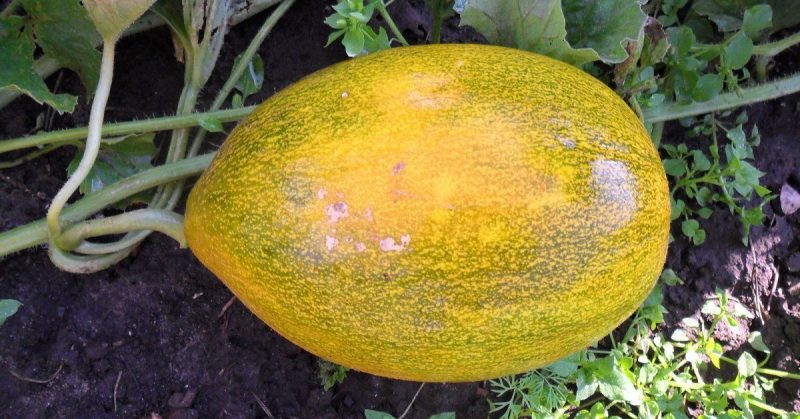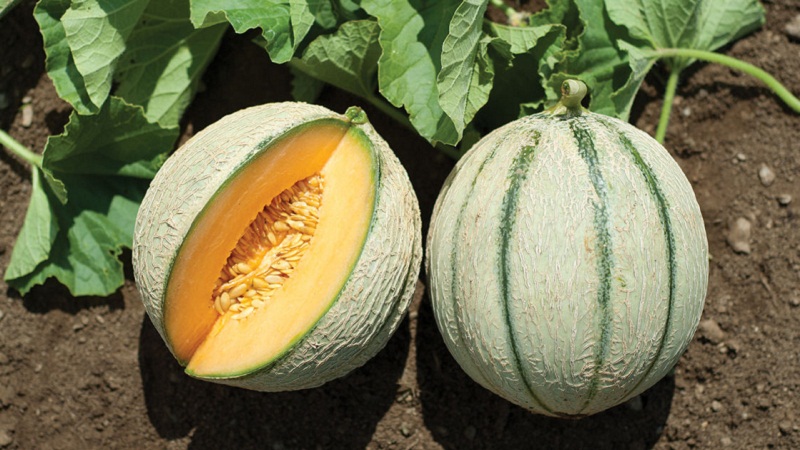Pests and diseases of melons: what are they and how to deal with them
Like all cultivated plants, melons are susceptible to pests and various diseases caused by bacteria, viruses, fungi. The main sources of infection are infected seeds, weeds, and soil. Timely identification of signs of plant damage and adequate treatment will not only preserve the future harvest, but also increase it.
The content of the article
Melon disease
Melons are susceptible to diseases common to all melons. The culture becomes infected through weeds or the remains of other plants, soil, water. Infections are transmitted by pests, wind, rodents and the person himself on infected tools.
Powdery mildew
The disease manifests itself with a small white bloom on the leaves, stems, petioles, which is why the affected parts of the bushes darken and dry out. Hot and dry weather is the main reason for the spread of powdery mildew. It is provoked by the wind and insects that transfer parts of infected plants to healthy ones.
Peronosporosis
Peronosporosis, or downy mildew, is a fungal disease, accompanied by the appearance of bright yellow-green spots on the upper side of the leaves. Subsequently, they become wet, acquire a brownish tint, and dry out. Sporangia form on the underside of the leaves, which release fungal spores carried by wind and insects to healthy melons.
Reference! The difference between powdery mildew and peronosporosis is the presence of sporangia on the back of the leaves.
Ascochitosis
With ascochitis, the root collar is affected by the fungus. The first symptoms are pale spots that grow until they cover the entire root collar. At the same time, the leaves, stem and fruits themselves become soft and black, and then dry out.
As a result, the stem is destroyed, the ripe spores are spread by wind and insects to healthy melons. The main causes of the disease are high air humidity, low soil temperature.
Fusarium
Fusarium wilting is almost asymptomatic or manifests itself as gray spots on the leaves and stems. The bushes dry up in the period from 2 to 10 days. Fruits ripened on diseased plants lose their juiciness, aroma and keeping quality. The causative agents of the disease live not only on the remains of plants, but also in the soil, on the seeds of dead crops.
Root rot
Weakened melons are prone to root rot. In young plants, the roots and stems become brown, thin, then wither and die. Mature melons have yellow leaves. At the fruiting stage, melons are not ripen or rot: the flesh of the pumpkin with the fungus becomes covered with brown spots inside.
Anthracnose
With anthracnose, or copperhead, the leaves are covered with brown or pink rounded spots, which increase over time. As a result, holes form in place of the spots, and the leaves curl into loops, which then become thin and break. The fruits of diseased plants are deformed, become rotten inside. The flesh is covered with brown or red rot.
Septoriasis
Septoria, or white spot, is caused by fungal organisms. Affected plants develop white, rounded spots. Over time, the central parts of the spots darken, indicating that the fungus is ready to spray spores. The disease develops in damp rainy weather, when spores, together with liquid, fall on healthy bushes. The pathogen remains in the soil for a long time.

Cucumber mosaic
This viral disease manifests itself in the form of green-yellow mosaic spots on the leaves, which are deformed, twisted. The fruits become covered with warts, cracks appear at the base of the stems, the growth of bushes slows down. The virus persists on the roots of plants and is transmitted by the melon aphid.
Gray mold
Fungal disease is common among young melons. The ovaries of the affected plants become watery, covered with mold and fungus, which remains in the soil for 2-3 years. Favorable conditions for the disease are humid weather with a temperature of + 15 ° C (at higher rates, the fungus spreads more slowly).
Cladosporium
Cladosporium, or olive spot, is a fungal disease. The leaves of the culture are covered with dark, rounded spots, which grow until they cover the entire surface. The fruits are covered with jelly-like droplets that turn into lacerations. Sharp temperature changes, abundant or irregular watering contribute to the development of cladosporia.
Bacteriosis
Initially, bacterial spotting affects the leaves, stems, then spreads to the fruits. The main symptoms are medium-sized brownish-brown greasy spots on plants, the formation of drops with a cloudy liquid on the backs of the leaves on rainy days, glass-like ovaries. Bacteriosis actively develops in high humidity and high temperatures.
Treatment

Melons begin to heal when the first symptoms appear. This will keep the plantings from further spreading the infection:
- powdery mildew - the bushes are treated with 80% sulfuric solution with an interval of 8-10 days;
- peronosporosis - use a solution of urea (1 g per 1 liter of water) or 1% Bordeaux liquid (1 liter per 10 m2), every 10 days apply "Topaz" or "Oxyhom";
- ascochitis - a 1% solution of Bordeaux liquid is used, potash dressings are applied, the soil is disinfected;
- fusarium - isolate and destroy the affected plants from healthy ones (the latter are sprayed with a potassium-phosphate solution: 5 g per 10 l of water);
- root rot - the affected plants are removed, the soil is regularly loosened, the bushes do not overmoisten;
- anthracnose, septoria - leaves and fruits are sprayed with a 1% solution of Bordeaux liquid or sulfur powder;
- cucumber mosaic, cladosporia, bacteriosis - diseased plants are destroyed;
- gray mold - the bushes are treated with a solution of 1 g of zinc sulfate, 10 g of urea, 2 g of copper sulfate and 10 liters of water.
Prevention methods
To prevent a culture from diseases, both universal methods and methods of preventing specific diseases are used. To increase the general immunity of the melon, the soil is regularly weeded from weeds, the rules of crop rotation are observed, and dead and infected fruits and bushes are destroyed.
They carry out prevention against specific diseases:
- against powdery mildew, root rot, fusarium, plants are systematically watered;
- after harvesting, the soil is plowed: this saves future plantings from peronospora, ascochitosis, fusarium (against septoria, the earth is dug up especially deeply, up to 25-30 cm);
- heat treatment of seeds before planting with warm water (+ 45 ° C): this protects the seedlings from peronospora, cucumber mosaic;
- melons are fed with potash fertilizers to prevent ascochitis;
- seeds are treated before planting: against peronosporosis and other fungal diseases, they are soaked in a 1% solution of potassium permanganate for 20 minutes or in a solution of "Fitosporin-M" (1.5 g / l), against fusarium - in a 0.1% solution "Baktofita" for 3 hours, from root rot use a 40% formalin solution for 5 minutes, from bacteriosis - a solution of potassium permanganate, aloe juice or hot water.
Pests
Melon plantings are threatened by many pests that are easily recognized when they appear on plants:
- melon aphid - gathers on the back of the leaves, which then turn yellow, curl, die off;
- spider mite - lives on the back of the leaves, they turn yellow, covered with red spots. A tick leaves a cobweb, sucks out sap from plants, which leads to their death;
- wireworm larva - holes appear on fruits and stems through which insects eat the pulp and destroy the stem;
- caterpillar gnawing scoop - the entire stem is dotted with bite marks;
- melon fly - adults fly over melons, holes appear in the fruits, which are gnawed by larvae, pests carry viral and fungal diseases.
Control methods
Both traditional methods and chemical preparations are used to fight insects:
| Pest | Control methods |
| Melon aphid |
|
| Spider mite |
|
| Wireworm larva |
|
| Gnawing scoop caterpillar |
|
| Melon fly |
|
reference! To kill wireworm eggs, it is enough to dig up the soil to expose the pests to the light. The sun's rays will dry them out.
Tips & Tricks

Tips from experienced farmers to help you keep your crops safe and maximize your yield:
- constantly look after melons: weed the beds, water regularly, spray the bushes from pests, remove weeds and infected fruits;
- to implement the correct crop rotation after the melon, sow the soil with annual and perennial grasses;
- to combat wireworm larvae and gnawing moth caterpillars when planting a culture, add 1 tsp to each well. ground eggshell.
Read also:
Overview of Chinese Bitter Melon (Momordiki).
What is good about the Kassaba melon, how to choose and grow it.
Delicious recipes for melon blanks for the winter - lick your fingers!
Conclusion
The best ways to control plant diseases is through proper care and prevention. To prevent most diseases, crop rotation is observed, the beds are weeded, dead and diseased plants are removed, and seeds are disinfected before planting. They use special preparations against pests, destroy bushes affected by insects.